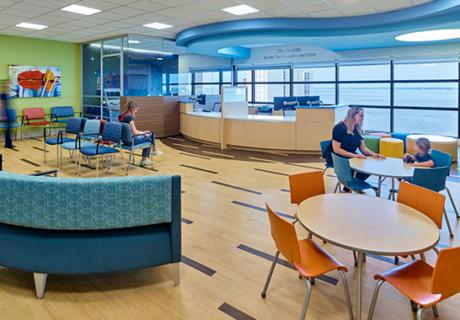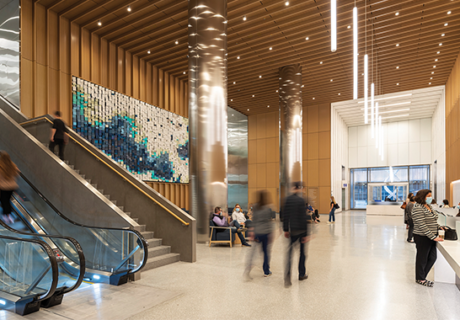PHOTO TOUR: Sir Robert Ogden Macmillan Centre, Harrogate District Hospital
The Sir Robert Ogden Macmillan Centre is a new outpatient oncology center that provides consulting, treatment, and patient support facilities in a standalone facility at Harrogate District Hospital (Harrogate, England).
Designed by IBI Group (Sussex, U.K.), the project had two key drivers: To achieve appropriate functional relationships and clinical adjacencies and to create a meaningful response to context both within and beyond the hospital site and the adjoining conservation area.
The completed facility takes the form of two “pebbles.” These non-institutional shapes avoid long, linear corridors while helping to provide identity and a sense of place for the center’s key functions.
Durable exterior materials reinforce their curved forms and emphasize their different functions with one clad in zinc and the other in a smoother finish. Both also make use of locally sourced stone to feature areas.
The asymmetrical relationship between the two pebbles, their varying heights, and the use of complementary materials create visual interest from vantage points both within and around the center while grounding the building to its surroundings.
The first unit houses consulting, examination, therapies, and information facilities on the first floor and administrative and administrative and staff facilities on a smaller second level. A main waiting area offers an opportunity for patients and carers to interact, share experiences, and offer mutual support. The waiting area and surrounding clinical and treatment spaces are arranged so that they can be isolated and the space used for support groups, meetings, and other activities during evenings and on the weekends.
The second building is accessible via a glazed bridge and provides space for chemotherapy and support facilities arranged around a large treatment area, which can be sub-divided to cater to patient needs.
The design takes a holistic approach to the integration of interiors, landscaping, and art in order to create a tranquil, reassuring, and non-institutional environment. A healing garden is located at the heart of each pebble and is designed to help calm those undergoing stressful experiences, provide distraction during long and repeated treatment procedures, and offer opportunities to escape from the clinical environments and get a breath of air.
The result is a patient-centric design that avoids institutional references and is flexible enough to adapt as clinical services evolve.




